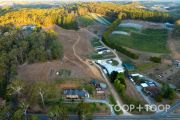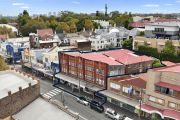
Sydney family buys Dunedoo's Pine Ridge Station for $3.3 million
A grand homestead considered one of the most historic landmarks in the NSW Central West has sold to a Sydney family for $3.3 million, part of a growing number of tree-change buyers looking to the region during the COVID-19 crisis.
Pine Ridge, at Narangarie Road, Dunedoo, received four offers and sold for more than double its 2015 purchase price.
Built circa 1860, the historic sandstone property is 85 kilometres from Mudgee and 4.5 hours from Sydney. It spans 827 square metres and was built by George Henry Cox, a pastoralist and sheep breeder.
George was part of the pioneering Cox family, one of four families who settled in the Liverpool Plains and founded Mudgee.
The property was used as a trotting stud with track before being sold to a New Zealand buyer in 1899.
After the First World War, Pine Ridge was divided into soldier settlements.
From the late 1970s, a rear admiral of the Australian Navy owned Pine Ridge until 2015 when he sold it to its current owner, retired stock and station agent Dennis Woods, who made the tough decision to sell due to health reasons.
Buyer interest was strong from across Australia including Western Australia, the Northern Territory, Victoria and Queensland, with inquiry from metropolitan-based buyers outnumbering rural buyers.
“The homestead itself is one of very few in the district, and one of very few in the country that has that grandeur,” McGrath Central Tablelands sales manager Adam Woods said.
“To have over 800 square metres of sandstone homestead with 15-foot [4.5-metre] ceilings that’s completely intact and has its integrity from the 1860s … it’s stepping back in time and is an appreciation of days gone by.”
In addition to a watch tower, seven bedrooms, formal living rooms with fireplaces, a billiards room, library, sewing room and wraparound verandah, Pine Ridge features ornate pressed-metal ceilings, leadlight windows, 11 fireplaces and a grand leadlight entrance door.
A new kitchen, bathroom, polished timber floors, new carpets and paint are among the recent renovations.
Twelve dams, a four-bedroom manager’s residence, a third residence, as well as new cattle and sheep yards, a machinery shed plus stone woolshed, stables, hay sheds and silos complete the property, which is set across 964 hectares and has a 500-metre frontage to Coolaburragundy River.
It suits 150 to 200 breeding cows, or 200 to 300 steers.
Mr Woods said the new owners saw the value of a country lifestyle and would continue to run Pine Ridge as a farm, with future plans to make it their prime residence.
“It’s very hard to find good properties of scale like Pine Ridge at the moment,” he said.
“We are seeing a massive growth in that asset class. That’s [Pine Ridge] a property that traded in 2015 for $1.55 million, then selling at $3.3 million.”
The decision to trade city life for a rural lifestyle has been a popular move with many buyers amid the COVID-19 pandemic, with Mr Woods saying about 30 per cent of purchasers had been those seeking a tree change.
“It shows that shift. People have slowed down and it has showed them what they want in life with aspirations for a simple life,” he said.
“The type of ‘tree-changer’ we are attracting is different to what it was 10, 20 years ago where we attracted retirees who could no longer live in metropolitan areas and they had to sell their primary place of residence to afford to retire.
“We are actually attracting 30 to 50-year-olds with young families. And it is as much about a financial decision as it is about a lifestyle decision, and that’s definitely the open spaces but it’s the slower pace of life, having more time with their families.
“It is the fact that rural communities are now more connective with internet broadband so people can run businesses remotely.”










